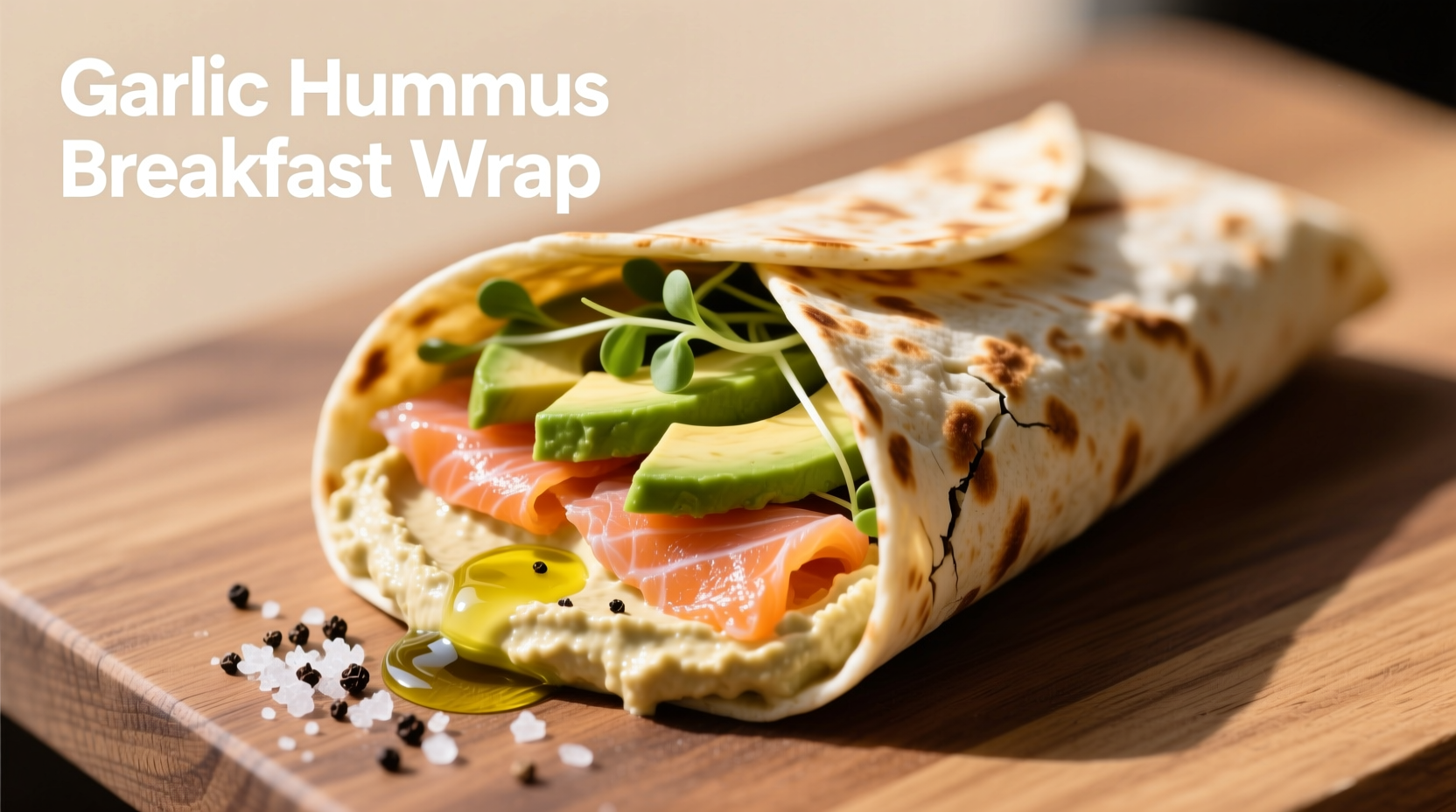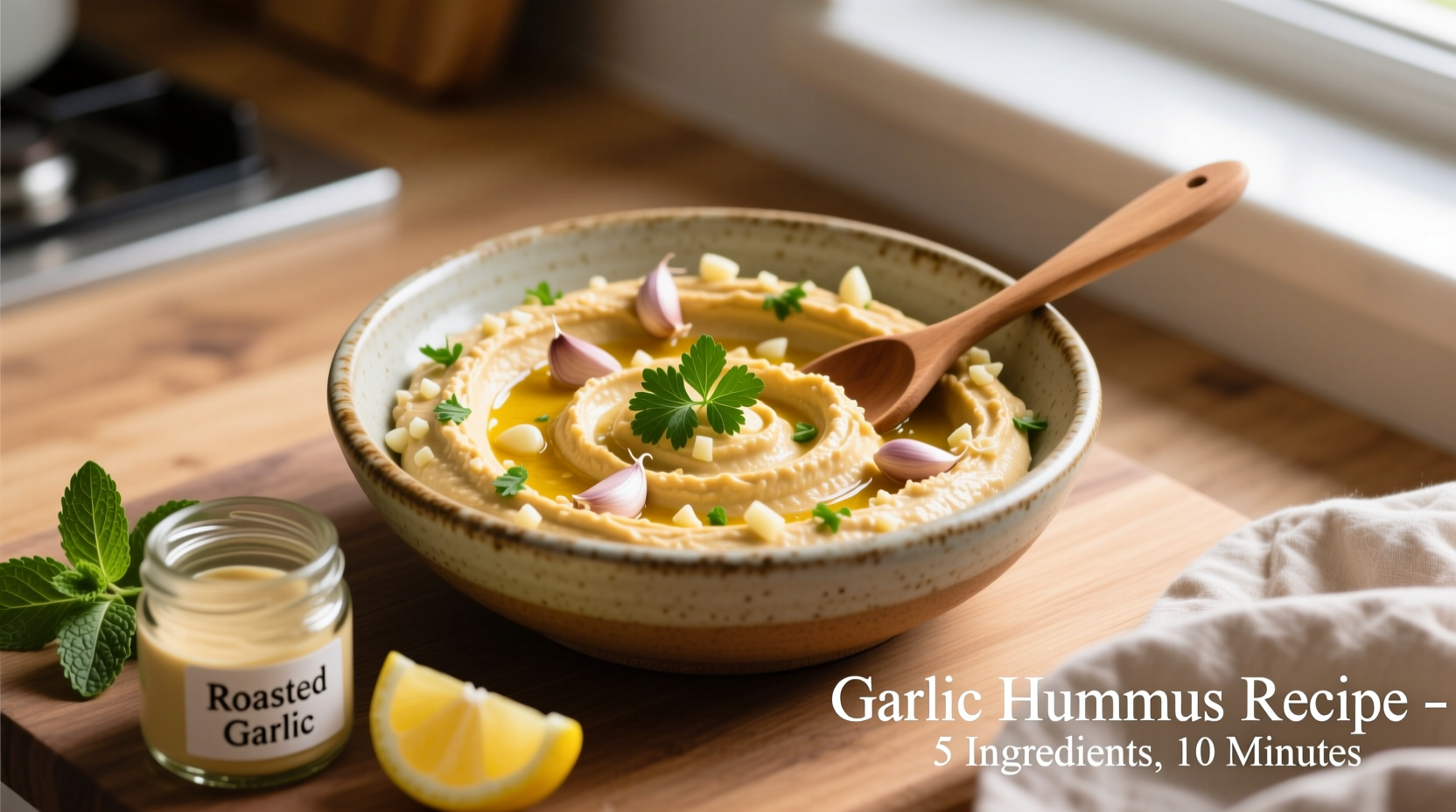Garlic hummus isn't just a dip—it's your secret weapon for creating restaurant-quality meals with minimal effort. This creamy chickpea spread with its bold garlic notes works as a sauce, spread, binder, and marinade across multiple cuisines. Our tested recipes solve the common problem of "what to do with leftover hummus" while delivering balanced nutrition and authentic flavors.
Why Garlic Hummus Elevates Everyday Cooking
Unlike plain hummus, the garlic variety adds instant depth through allicin—the compound formed when garlic is crushed. This sulfur-containing molecule enhances umami perception while providing antimicrobial properties that extend freshness. According to USDA nutritional data, two tablespoons of garlic hummus delivers 5g of plant-based protein and 2g of fiber while remaining low in saturated fat.
| Application | Texture Benefit | Flavor Enhancement |
|---|---|---|
| Sauce base | Creamy consistency without dairy | Garlic notes complement roasted vegetables |
| Sandwich spread | Prevents sogginess better than mayo | Acidic tang cuts through rich meats |
| Protein marinade | Creates flavorful crust when roasted | Garlic penetrates proteins for deeper seasoning |
5 Practical Garlic Hummus Recipes for Real Kitchens
1. 15-Minute Mediterranean Hummus Bowl
Perfect for lunch prep—ready in 15 minutes, serves 2
This balanced bowl combines protein, healthy fats, and vegetables in one container. The garlic hummus acts as both dressing and flavor foundation.
Ingredients:
- 1 cup garlic hummus (store-bought or homemade)
- 1 cup cooked chickpeas, rinsed
- 1 cup cherry tomatoes, halved
- 1 cucumber, diced
- 1/2 red onion, thinly sliced
- 2 tbsp lemon juice
- 1 tbsp olive oil
- Handful of fresh parsley
Method:
- Whisk 1/4 cup hummus with lemon juice and olive oil to create dressing
- Arrange chickpeas, tomatoes, cucumber and onion in meal prep containers
- Pour dressing over ingredients and toss gently
- Top with remaining hummus dolloped in center
- Sprinkle with parsley and serve immediately
Pro Tip: For best texture, add dressing just before eating to prevent sogginess. This recipe adapts well for vegan diets by omitting feta cheese.
2. Hummus-Stuffed Chicken Breasts
Weeknight dinner solution—30 minutes total, serves 4
This professional technique transforms ordinary chicken into an impressive meal using garlic hummus as both filling and basting sauce.
Why It Works: The hummus's high moisture content (approximately 60% water) keeps chicken juicy during cooking while the garlic compounds penetrate the meat for deeper flavor.
Method:
- Create pocket in thick chicken breasts using paring knife
- Mix 1/2 cup garlic hummus with 1/4 cup crumbled feta and chopped spinach
- Stuff mixture into chicken pockets
- Season exterior with paprika and black pepper
- Sear in hot skillet 3 minutes per side
- Finish in 375°F oven for 12-15 minutes until internal temperature reaches 165°F
- Rest 5 minutes before slicing
Food Safety Note: According to FDA guidelines, poultry must reach 165°F internal temperature to ensure safety. Use a digital thermometer for accuracy.
3. Hummus Breakfast Wrap with Smoked Salmon
Brunch-ready in 10 minutes, serves 1

This protein-packed breakfast combines Mediterranean flavors with traditional brunch elements. The garlic hummus replaces less healthy spreads while adding complex flavors.
Key Technique: Spread hummus thinly on the tortilla before adding other ingredients—this creates a moisture barrier that prevents sogginess. Chefs call this the "flavor foundation" technique.
4. Hummus Pasta Salad with Roasted Vegetables
Potluck-perfect dish—25 minutes active time, serves 6
This innovative recipe uses garlic hummus as the base for a creamy dressing that clings perfectly to pasta shapes. Unlike mayo-based salads, it stays fresh longer thanks to hummus's natural preservatives.
Dietary Adaptation: For gluten-free version, use chickpea pasta. The hummus's starch content helps the dressing adhere equally well to alternative pasta types.
5. Hummus Pizza Base with Roasted Garlic
Game-changing alternative to tomato sauce—20 minutes, serves 4
This Middle Eastern-inspired pizza uses garlic hummus as the sauce base, creating a creamy contrast to traditional tomato varieties. The hummus caramelizes slightly when baked, developing nutty notes that complement roasted vegetables.
Pro Tip: Thin the hummus with 1-2 tablespoons of water before spreading on pizza crust—this prevents burning during high-heat baking. Chefs at the Culinary Institute of America recommend this technique for spreadable consistency.
Maximizing Your Garlic Hummus: Practical Tips
Storage Guidelines: Homemade garlic hummus keeps for 5-7 days in airtight containers according to FDA food safety standards. Store-bought varieties typically last 7-10 days after opening. Always check for signs of spoilage including sour smell or mold.
Texture Troubleshooting:
- Too thick? Add ice water, one teaspoon at a time, while blending
- Too thin? Blend in additional cooked chickpeas or tahini
- Losing flavor? Stir in fresh lemon juice and minced garlic before using
Flavor Boosters: Professional chefs often enhance store-bought hummus with toasted cumin seeds, smoked paprika, or a drizzle of high-quality olive oil. These additions create restaurant-quality depth without significant extra effort.
Avoiding Common Garlic Hummus Mistakes
Many home cooks make these critical errors that compromise flavor and texture:
- Overheating: Garlic hummus breaks down above 160°F—always add to dishes at the end of cooking
- Incorrect thinning: Using milk instead of water creates separation issues
- Ignoring acidity balance: Lemon juice is essential to cut through richness—adjust to taste
- Storage mistakes: Leaving hummus at room temperature longer than 2 hours risks bacterial growth
Frequently Asked Questions
Can I use garlic hummus as a mayonnaise substitute in sandwiches?
Yes, garlic hummus makes an excellent mayonnaise substitute in sandwiches. It provides similar creamy texture while adding protein and fiber. For best results, spread a thin layer on both bread slices to create a moisture barrier that prevents sogginess. This substitution works particularly well with turkey, chicken, and vegetable sandwiches.
How do I prevent garlic hummus from separating when used in hot dishes?
To prevent separation, never boil garlic hummus. Add it to hot dishes when they've cooled to 160°F or below. For pasta dishes, mix hummus with a small amount of the starchy pasta water first—the starch helps emulsify the mixture. Professional chefs often temper hummus by gradually adding small amounts of warm liquid while whisking constantly.
What’s the best way to enhance store-bought garlic hummus?
Boost store-bought garlic hummus by stirring in fresh lemon juice, a drizzle of high-quality olive oil, and a pinch of toasted cumin. For extra depth, blend in one roasted garlic clove per cup of hummus. These additions create restaurant-quality flavor without significant extra effort while maintaining the convenience of store-bought product.
Can I freeze garlic hummus for later use?
Yes, garlic hummus freezes well for up to 3 months. Portion into ice cube trays for single servings, then transfer to freezer bags once solid. Thaw overnight in the refrigerator and stir vigorously to restore texture. Note that frozen hummus may separate slightly—adding a teaspoon of water while stirring usually resolves this issue.











 浙公网安备
33010002000092号
浙公网安备
33010002000092号 浙B2-20120091-4
浙B2-20120091-4